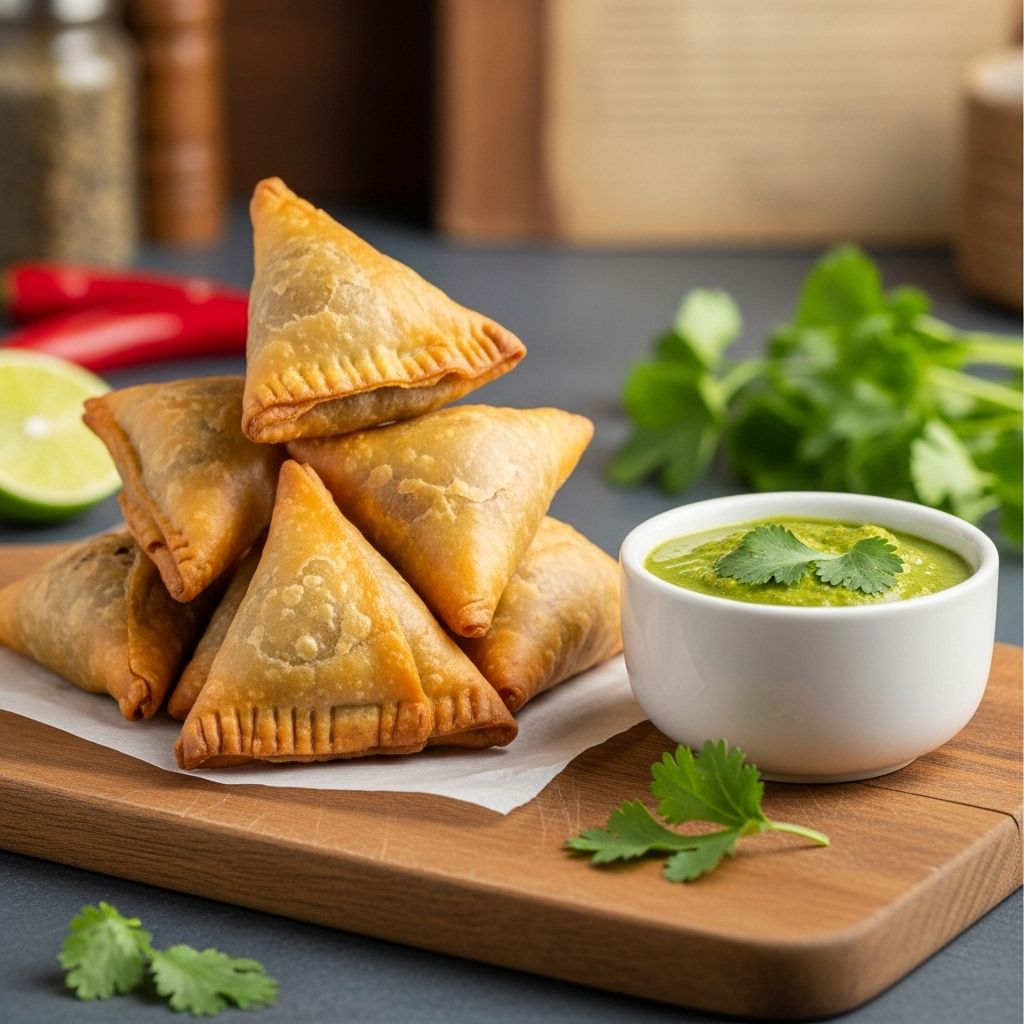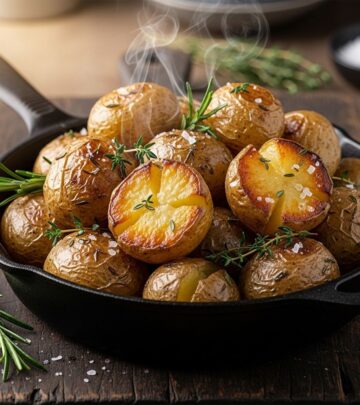Beef Samosa Recipe: 4 Easy Steps To Authentic Kenyan Delights
Learn how to make authentic Kenyan beef samosas with homemade pastry and a spiced beef filling for a delicious snack or appetizer.

Image: HearthJunction Design Team
Kenyan Beef Samosas: Authentic, Flavorful, and Crispy Delights
Kenyan beef samosas are savory, crispy pastries filled with spiced ground beef and vegetables—an iconic snack cherished in Kenya and across East Africa. They are deeply woven into Kenyan food culture, often enjoyed during family gatherings, celebrations, or simply with evening tea. This guide walks you through every step, from preparing the dough and flavorful filling to expert folding and frying techniques, so you can recreate this street food favorite in your own kitchen.
What Are Kenyan Beef Samosas?
Samosas are triangular pastries, traditionally deep-fried, that are filled with a mixture of meats, vegetables, or a combination of both. While versions exist throughout the Middle East, India, and Africa, the Kenyan style features a rich beef filling infused with spices, onions, peas, and herbs. The thin, crispy pastry shell is essential to achieving the perfect crunch with every bite, and homemade dough makes all the difference.
Ingredients Overview
The key to delicious samosas is fresh, aromatic spices and high-quality ingredients. Kenyan beef samosas typically include:
- Ground Beef: Lean and flavorful, forms the base of the filling.
- Vegetables: Onion, peas, and scallions contribute sweetness and texture.
- Aromatic Spices: Garlic, cumin, coriander, fresh cilantro, and jalapeño bring depth and heat.
- Pastry Dough: A simple homemade mix of flour, salt, oil, and water creates a crispy shell.
Ingredient List
| Filling | Pastry |
|---|---|
| 1 lb (450g) ground beef | 3 cups (375g) all-purpose flour |
| 1 ½ tbsp vegetable oil | ¼ tsp salt |
| 1 medium red onion, diced | 2 tsp vegetable oil |
| 1 clove garlic, minced | 1 cup water + 2 tbsp extra |
| 1 jalapeño, minced | 1 tbsp flour mixed with 1 tbsp water (for sealing) |
| 1 tsp salt | 3 cups canola oil (for frying) |
| 1 tsp black pepper | Lime wedges, for serving |
| 1 tsp ground coriander | |
| 1 tsp cumin | |
| 4 scallions, diced | |
| 1 cup frozen peas (defrosted) | |
| 2 tbsp fresh cilantro, chopped |
Step-by-Step Instructions
1. Prepare the Beef Filling
- Heat oil in a large pan over medium-high heat. Add ground beef and break it up with a spatula. Cook for 3 minutes until it begins to brown.
- Add diced onion and sauté until translucent and the beef is fully browned, about 4 minutes.
- Stir in minced garlic, jalapeño, salt, black pepper, ground coriander, and cumin. Cook, stirring, for 2 minutes to release the spices’ aromas.
- Add the diced scallions and mix in the peas and fresh cilantro. Cook for another 2 minutes. Remove from heat and allow to cool completely.
2. Make the Samosa Pastry
- In a large bowl, combine flour, salt, and vegetable oil. Gradually add water while mixing until a dough forms and pulls away from the sides of the bowl.
- Transfer the dough to a lightly floured surface and knead for about 4 minutes, until the dough is smooth and soft.
- Shape the dough into a ball, brush with a bit of oil, cover with plastic wrap and a warm damp tea towel. Let rest for 30 minutes.
- Uncover and roll the dough into a 10-inch (25-cm) log. Cut into 10 equal pieces. Roll each piece into a ball, then flatten into a 10-inch circle. Stack circles as you go, lightly dusting with flour to prevent sticking.
3. Assemble the Samosas
- Cut each dough circle in half to create semi-circles.
- Take one semi-circle, form a cone by folding the straight edge together and sealing with a flour-water paste.
- Fill the cone with the cooled beef filling. Do not overfill.
- Seal the open edge with more flour-water paste. Press firmly to ensure there are no gaps.
- Repeat with remaining dough and filling, covering assembled samosas with a tea towel to prevent drying.
4. Fry the Samosas
- Heat canola oil in a large, deep skillet or fryer to 350°F (175°C).
- Carefully lower samosas into the hot oil in small batches. Do not overcrowd.
- Fry for about 3-5 minutes, turning occasionally, until golden brown and crisp.
- Remove with a slotted spoon and drain on paper towels.
Tips for Perfect Samosas
- Do not overfill: Too much filling can cause samosas to burst during frying.
- Seal tightly: Use a generous flour-water paste to seal all edges.
- Maintain oil temperature: Overheated oil cooks the outside too quickly, leaving the inside uncooked.
- Cool filling before use: Hot filling can make the dough soggy and harder to seal.
- Serve hot: Samosas are best enjoyed fresh, hot, and crispy, with lime wedges or your favorite dipping sauce.
Serving Suggestions
Kenyan beef samosas are versatile and can be enjoyed as:
- A snack with afternoon tea or coffee
- An appetizer at parties or family gatherings
- A lunchbox treat or picnic food
- Accompaniment to salads or chutneys for a light meal
Traditionally, samosas are served with a squeeze of fresh lime. For added flavor, try pairing with mango chutney, tamarind sauce, or a spicy chili dip.
Storing and Reheating
- Refrigeration: Store leftover samosas in an airtight container in the refrigerator for up to 3 days.
- Freezing: Arrange unfried or fried (and cooled) samosas in a single layer on a tray and freeze. Once solid, transfer to a freezer-safe bag or container for up to 2 months.
- Reheating: Reheat in the oven at 350°F (175°C) until warmed through and crisp. Avoid microwaving, as the pastry may get soggy.
Variations and Substitutions
- Vegetarian Samosas: Replace beef with a mixture of potatoes, peas, carrots, and spices.
- Chicken Samosas: Substitute ground beef with ground chicken or turkey.
- Spice Level: Adjust jalapeño and black pepper to taste, or add chili flakes for extra heat.
- Pastry Shortcuts: Use store-bought spring roll wrappers for a quicker version, although homemade dough yields the best texture.
Kenyan Beef Samosas in Culture
In Kenya, making samosas is both a culinary craft and a social activity. Family members often gather to prepare large batches for special occasions, with each person lending a hand in shaping or filling. The tradition strengthens bonds and ensures every samosa is made with care. Samosas are also popular street food, found in markets, at bus stops, and in eateries throughout East Africa, prized for their portability and satisfying flavor.
Nutritional Information (Approximate Per Samosa)
- Calories: 190
- Fat: 8g
- Carbohydrates: 20g
- Protein: 8g
- Fiber: 2g
- Sodium: 350mg
Frequently Asked Questions (FAQs)
Q: Can I make samosas ahead of time?
A: Yes, you can assemble the samosas and freeze them before frying. Fry straight from frozen, adding an extra minute or two to the cook time.
Q: What oil is best for frying samosas?
A: Use a neutral, high-heat oil such as canola or vegetable oil for the best results and flavor.
Q: Can I bake samosas instead of frying?
A: Yes, brush with oil and bake at 400°F (200°C) until golden and crisp, though they won’t be as crispy as deep-fried versions.
Q: How do I prevent the samosa pastry from drying out?
A: Keep shaped or rolled dough covered with a damp towel as you work to prevent drying and cracking.
Q: What dips go well with Kenyan beef samosas?
A: Samosas pair well with tangy tamarind chutney, sweet-and-spicy mango chutney, or classic cilantro-mint yogurt sauce.
Conclusion
Kenyan beef samosas bring together vibrant spices, tender beef, fresh herbs, and expert technique to create a snack that is beloved across generations. Whether you’re making them for a festive occasion or a simple treat for family and friends, these savory pastries promise flavor and crunch in every bite. With this comprehensive guide, you have all the tools and tips needed to master authentic Kenyan beef samosas at home. Enjoy the process and savor each bite!
References
Read full bio of Anjali Sayee












